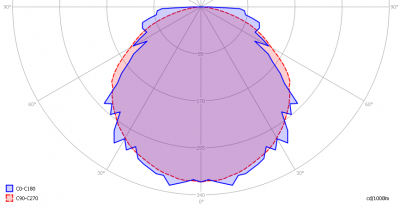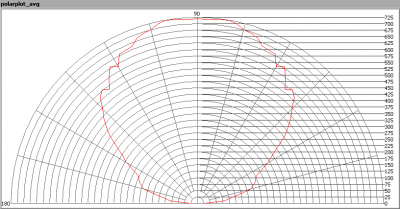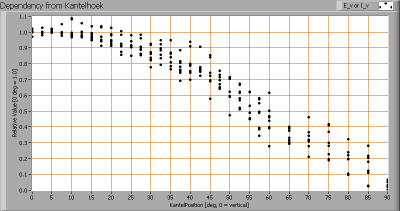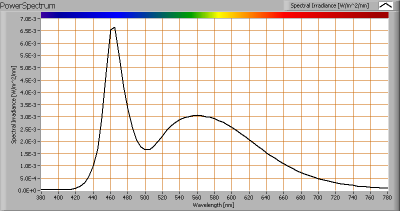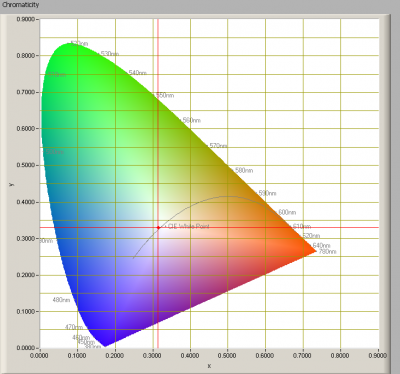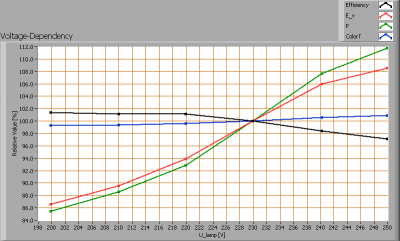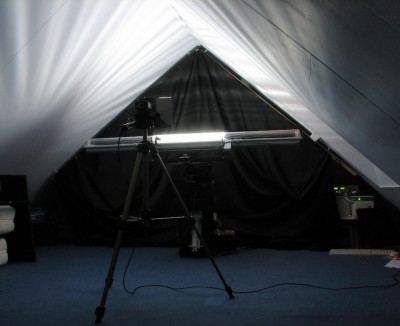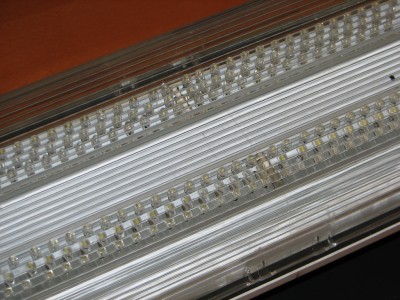LLE 5mm 6000K 1500mm double in IP65 luminaire
Posted by Marcel van der Steen in Led lights, Light measurements No Comments» presents a measurement set of two 1500 mm 5mm-LED tubes inside an IP65 luminaire. In this article the measurement data can be found as well as in Eulumdat format.
See this overview for a comparison with other light bulbs.
Summary measurement data
| parameter | meas. result | remark |
|---|---|---|
| Color temperature | 5470 K | Bright white |
| Luminous intensity Iv | 742 Cd | |
| Beam angle | 113 deg | A wide beam, which is to be expected from an FL-tube. |
| Power P | 35.7 W | |
| Power Factor | 0.91 | For every 1 kWh net power consumed, there has been 0.45 kVAhr for reactive power. |
| Luminous flux | 2275 lm | |
| Luminous efficacy | 64 lm/W | |
| CRI_Ra | 82 | Color Rendering Index. |
| Coordinates chromaticity diagram | x=0.313 and y=0.331 | |
| Fitting | FL-tube | |
| L x W x H external dimensions | 1550 x 170 x 110 mm | External dimensions of the IP65 luminaire |
| L x W dimensions luminous area | 1505 x 150 mm | Dimensions of the luminous area (used in Eulumdat file). This is here the cap of the IP65 luminaire. |
| General remarks | The ambient temperature during the whole set of measurements was 20-21 deg C.
Warm up effect: small effect, the temperature of the tube was almost stable after 30 minutes. Voltage dependency: consumed power and illuminance are dependent from the light bulb voltage, in a linear way. For the eulumdat file follow this link. A tube in this specific IP65 luminaire gives a light pattern with intensity differences, due to the variation of thickness of the transparent cover. Visible in this photo. |
Eulumdat lichtdiagram
With this article an eulumdat file is added. This is a file that a.o. indicates the radiation pattern around the light bulb. There are more parameters in the file, and these all can be read with help of the free open source program Qlumedit.
An interesting graph is the light diagram, indicating the intensity in the C0-C180 and the C90-C270 plane.
The light diagram giving the radiation pattern in the C0-C180 and C90-C270 planes.
The C0-C180 plane is perpendicular to the length axis of the tube. It indicates the luminous intensity sideways of the tube. The tube itself has a plastic transparent cover with ribs in it, explaining the somewhat dented curvature of the radiation pattern in this plane.
The C90-C270 plane indicates the radiation pattern in the plane in the same direction as the tube’s length.
Illuminance Ev at 1 m distance, or luminous intensity Iv
Herewith the plot of the averaged luminous intensity Iv as a function of the inclination angle with the light bulb.
The radiation pattern of the light bulb.
This radiation pattern shows a wide beam.
These averaged values are used (later) to compute the lumen output.
The intensity measurements (of each turn angle) as function of inclination angle.
This plot shows per inclination angle the intensity measurement results for each turn angle at that inclination angle.
When using the average values per inclination angle, the beam angle can be computed, being 113 degrees. However, this value is dependent from the plane observed.
Luminous flux
With the averaged illuminance data at 1 m distance, taken from the graph showing the averaged radiation pattern,it is possible to compute the luminous flux.
The result of this computation for this lamp is a luminous flux of 2275 lm.
Luminous efficacy
The luminous flux being 2275 lm, and the power of the light bulb being 35.7 W, yields a luminous efficacy of 64 lm/W.
A power factor of 0.91 means that for every 1 kWh net power consumed, a reactive component of 0.45 kVAr was needed.
| Light bulb voltage | 230 V |
| Light bulb current | 171 mA |
| Power P | 35.7 W |
| Apparent power S | 39.2 VA |
| Power factor | 0.91 |
Color temperature and Spectral power distribution
The spectral power distribution of this light bulb.
The measured color temperature is about 5450 K, bright white.
Chromaticity diagram
The chromaticity space and the position of the lamp’s color coordinates in it.
The light coming from this light bulb is close to the Planckian Locus (the black path in the graph).
Its coordinates are x=0.313 and y=0.331.
Color Rendering Index (CRI) or also Ra
Herewith the image showing the CRI as well as how well different colors are represented (rendered). The higher the number, the better the resemblance with the color when a black body radiator would have been used (the sun, or an incandescent lamp).
Each color has an index Rx, and the first 8 indexes (R1 .. R8) are averaged to compute the Ra which is equivalent to the CRI.
CRI of the light of this lightbulb.
The value of 82 is higher than the 80 which is considered a minimum value for indoor usage.
Note: the chromaticity difference is 0.0011 indicates the distance to the Planckian Locus. Its value is lower than 0.0054, which means that the calculated CRI result is meaningful.
Voltage dependency
The dependency of a number of lamp parameters on the lamp voltage is determined. For this, the lamp voltage has been varied and its effect on the following lamp parameters measured: illuminance E_v [lx], color temperature CT or correlated color temperature CCT [K], the lamppower P [W] and the luminous efficacy [lm/W].
Lamp voltage dependencies of certain light bulb parameters, where the value at 230 V is taken as 100 %.
The power consumed and the illuminance measurements do depend on the light bulb voltage applied. The dependence is in a linear way.
To check whether this dependency can lead to visible changes in illuminance for possible grid voltage changes, it is noted what variations occur when the lamp voltage varies around 230 V + and – 5 V. Then the illuminance varies between + and – 3 %. It will (likely) not be visible.
Warm up effects
After switch on of a cold lamp, the effect of heating up of the lamp is measured on illuminance E_v [lx], color temperature CT or correlated color temperature CCT [K], the lamppower P [W] and the luminous efficacy [lm/W].
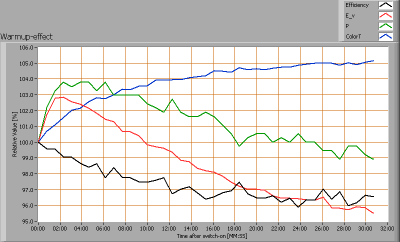
Effect of warming up on different light bulb parameters. The 100 % level is put at begin.
No noticeable effects seen. The temperature is stable after 30 minutes.
Measurement setup and illumination
The measurement setup of the tube in its IP65 luminaire
The light that passes through the IP65 housing, shows intenisity variations. One can see these intensities on the roof walls in the photo.
These intensity differences come from the IP65 cover, that consists of transparent material of varying thickness, due to the ribs in it.
The ribbed cover of the IP65 luminaire, leading to intensity differences of the light passing through.
The light measurement sensor (spectrometer) has a horn mouted in front of it, such to not see the light at the roof. Behind the IP65 luminaire (this is visible for the sensor) a black curtain is put, to prevent reflections against it becoming visible.

